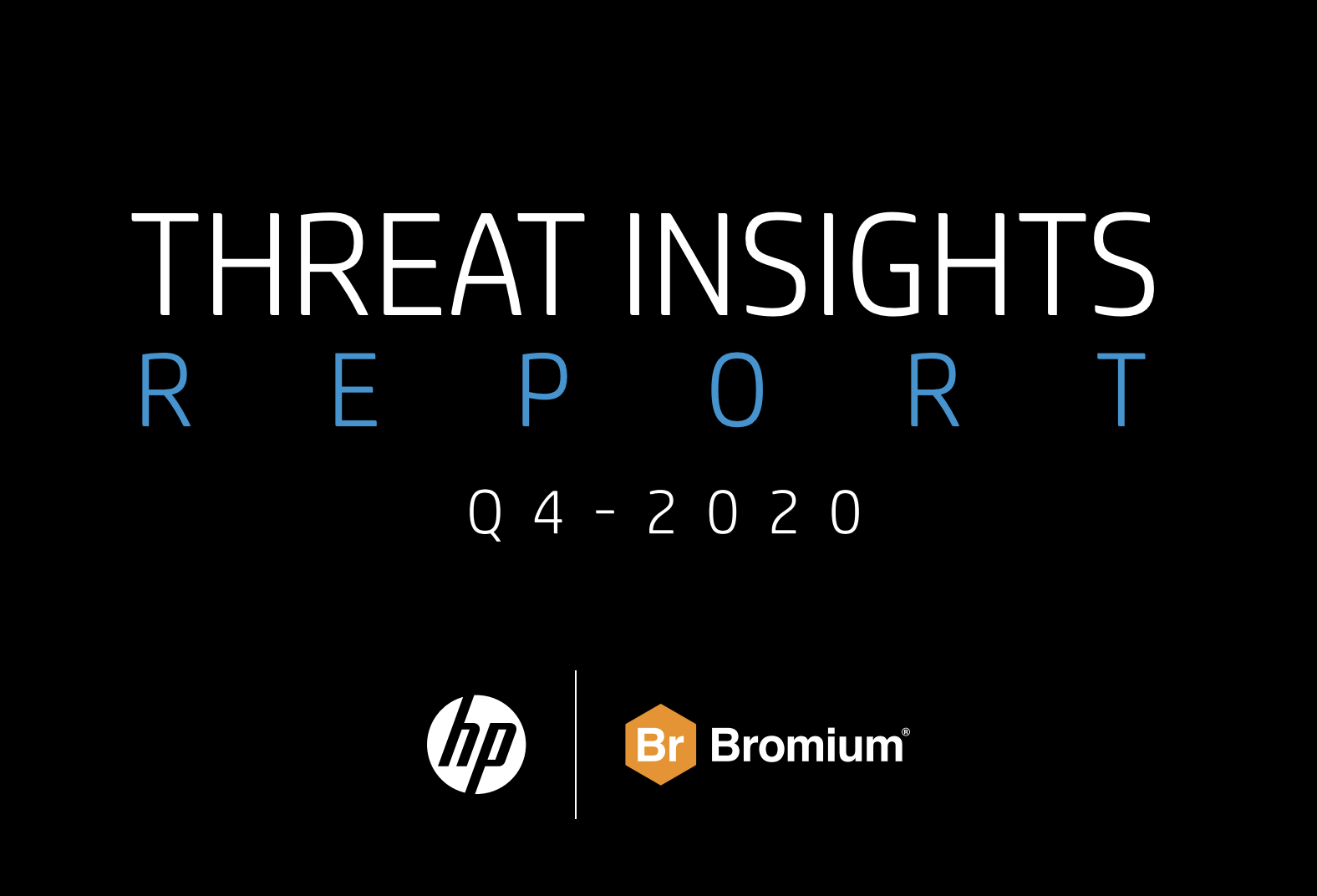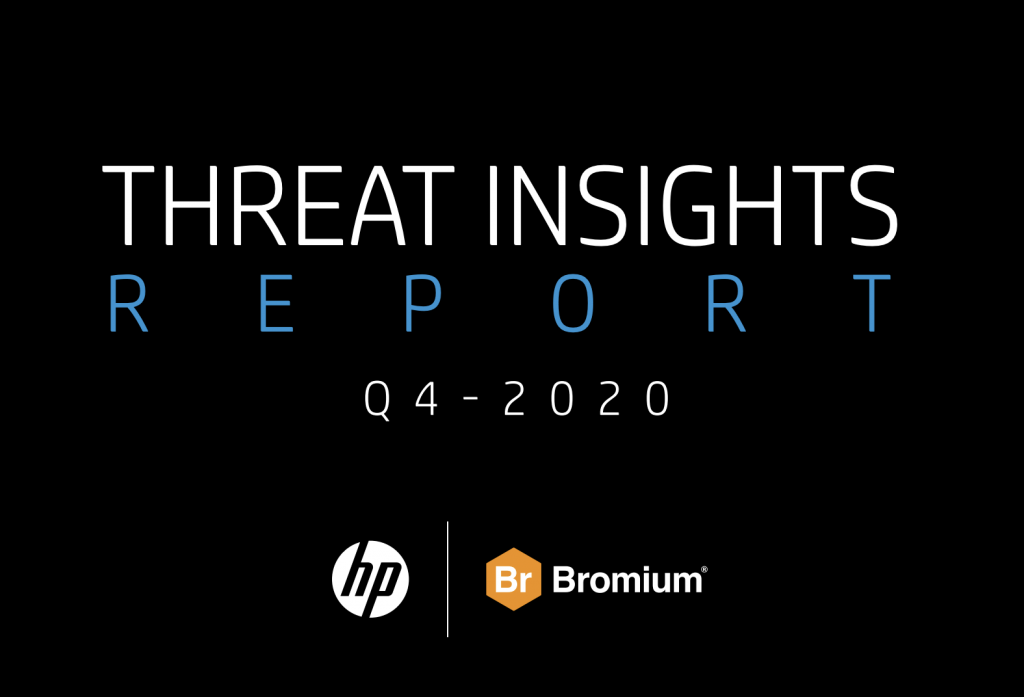29% of cyber threats previously unknown
March 17, 2021
 The HP threat intel team revealed rising web browser exploits, RAT-infested delivery alerts, DOSfuscation and other hacker activity.
The HP threat intel team revealed rising web browser exploits, RAT-infested delivery alerts, DOSfuscation and other hacker activity.
HP Inc. released its new Quarterly Threat Insights Report, providing analysis of real-world attacks against customers worldwide. The report found that 29% of malware captured was previously unknown, due to the widespread use of packers and obfuscation techniques by attackers seeking to evade detection. 88% of malware was delivered by email into users’ inboxes, in many cases having bypassed gateway filters. It took 8.8 days, on average, for threats to become known by hash to antivirus engines, giving hackers over a week’s ‘head-start’ to further their campaigns.
The report provides a unique glimpse into the behaviour of malware in the wild, as, unlike other endpoint security tools, which aim to prevent or intervene in an attack, HP Sure Click lets malware run, tricking malware into executing, while capturing a full infection chain within isolated, micro-virtual machines. This hardware-enforced approach to security renders malware harmless and keeps customers safe.
“This report highlights the deficiencies in traditional defences that rely on detection to block malware,” said Dr. Ian Pratt, Global Head of Security for Personal Systems at HP Inc. “Attackers have repeatedly found new ways to bypass traditional detection-based tools, making it more important than ever for organizations to build zero-trust design principles into their security architecture.”
Notable threats isolated by HP Sure Click included:
- Web Browser exploits leading to FickerStealer: A malware campaign that relied on misspelled domains of popular instant messaging services. Visitors were redirected to RigEK landing pages that attempted to exploit web browser and plugin vulnerabilities to infect visitors’ PCs with information-stealing malware called FickerStealer.
- Delivery-themed lures tempting users into letting the RATs in: A new Office malware builder called APOMacroSploit was used to target victims in delivery-themed spam campaigns, tricking them into opening weaponized XLS attachments, ultimately leading to the BitRAT remote access Trojan being deployed on their computers.
- The return of ZLoader: An increase in ZLoader banking Trojan activity, using a combination of techniques – including Word documents masquerading as pharmaceutical invoices that run malicious macros only after the document has been closed.
- The art of misdirection through DOSfuscation: Emotet’s final burst of activity before its takedown in January 2021 saw its operators modify the downloader using DOSfuscation techniques to make its obfuscation more complex. The downloader also generated an error message when opened, helping to avoid suspicion from users when the malicious documents didn’t behave as expected.
- Email thread hijacking of government targets: HP Sure Click stopped email thread hijacking attacks against government organisations in Central America, where stolen email data was used to craft convincing phishing lures to distribute Emotet.
“Opportunistic cybercrime does not show any signs of slowing,” commented Alex Holland, Senior Malware Analyst at HP Inc. “Cybercriminals are exploiting low-cost malware-as-a-service kits, which are proliferating in underground forums. Kits like APOMacroSploit, which emerged in Q4 2020, can be bought for as little as $50 (€42), illustrating just how low the barrier to entry is for opportunistic cybercrime. We have also seen threat actors continue to experiment with malware delivery techniques to improve their chances of establishing footholds into networks. The most effective execution techniques we saw in Q4 2020 involved old technologies like Excel 4.0 macros that often offer little visibility to detection tools.”
Other key findings in the report include:
- Trojans made up 66% of malware samples analysed, driven largely by malicious spam campaigns distributing Dridex malware, which a recent HP blog flagged as having increased in prevalence by 239%.
- 88% of malware detected was delivered via email – with the most common lures being fake invoice attachments – while web downloads were responsible for the remaining 12%.
- The most common type of malicious attachments were: documents (31%), archive files (28%), spreadsheets (19%) and executable files (17%).
- Malicious executables rose by 12%, with CVE-2017-11882 – a memory corruption flaw in Microsoft Office’s Equation Editor – accounting for nearly three-quarters of the exploits isolated by HP Sure Click.
- A 12% growth in malware that exploits CVE-2017-0199, which is commonly used to run malicious scripts to deploy malware when a user opens an Office document.
“Q4 saw attackers shift from Word documents to executable files to deliver RATs. There was an uptick in malicious email campaigns targeting German users with Agent Tesla and Formbook RATs that were delivered as executables attached to emails,” continued Holland. “The largest rise was in Dridex campaigns, which are typically used by attackers to deploy ransomware. Ultimately, any attacker gaining a foothold on an endpoint is bad news – they can use this access to scrape credentials, move laterally between systems, exfiltrate data, or sell their access to other cybercriminals – so it creates huge risk for businesses.”
“For every new malware variant hackers create, they have a few days’ head start to capitalize on their campaigns, infecting machines before detection tools catch-up. With automation, this process is now easier than ever” continued Dr. Pratt.
“Trying to detect every threat is futile, as something will always slip through the net,” Pratt added. “The best cyber defence is being able to isolate risks on the endpoint through micro-virtualization. This kind of hardware-enforced isolation removes the opportunity for malware to cause harm to the host PC – even from novel malware – because it does not rely on a detect-to-protect security model. By having security built in at the hardware level, endpoint devices can help to defend users and recover from attacks automatically, improving business resiliency. This way, businesses can carry on doing what they do best, safe in the knowledge that their users and data are protected.”
Categories : Around the Industry
Tags : Hackers HP Inc Malware Technology
























